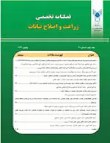Effect of salinity and seed size on germination response, seed conversion efficiency and antioxidant enzyme activity in barley under salt stress conditions
AbstractTo study the effect of salinity and seed size on germination response, seedling growth and seed conversion efficiency in barley under salt stress conditions, a factorial experiment based on a completely randomized block was conducted in 2018. The first factor was salinity in four levels (zero (control), 4, 8 and 12 dS/m) and the second factor was seed size (in three sizes, small sizes (1000 grain weight less than 25 g), average (1000 grain weight between 25-48 g), large (1000 grain weight above 48g). In this study, the highest seed germination percentage (89%), daily germination average (4.02% seed), root length (5.04 cm), stem length (5.32 cm), stem dry weight (0.026 g), was allocated to the zero level of salinity (control). Also, the lowest amount of antioxidant enzyme activity was assigned to zero salinity level. Among the different seed sizes, the highest germination percentage (86.56%), mean daily germination (4.9 seeds), were belonged to seed with small size and the highest root length (5.31 cm), stem length (5.94 cm), stem dry weight (0.026) and amount of antioxidant enzyme activity were observed in seed white large size. Among interactive treatments, the highest average daily germination time was observed in large-sized seed at 12 d.S and the highest root dry weight (0.065 g), seedling dry weight (0.091 g), the weight of stored grain consumption (0.062), and percentage of transfer of seed reserves was significant (78.96) was belonged to seed with large size in zero salinity (control).


